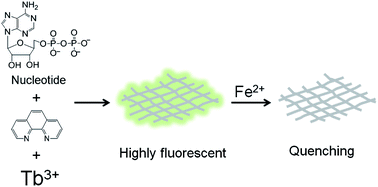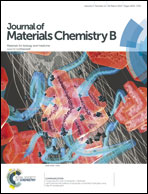Nucleotide/Tb3+ coordination polymer as a luminescent nanosensor: synthesis and sensing of iron(ii) in human serum†
Abstract
Metal organic coordination polymers have emerged as a new class of functional nanomaterials because of their flexible components and diverse architecture. Here, we report the synthesis of a luminescent sensing nucleotide/Tb3+ coordination polymer by the self-assembly of a biomolecule nucleotide, a lanthanide ion and a functional ligand 1,10-phenanthroline. Due to the incorporation of 1,10-phenanthroline as both a sensitizer and a recognition unit, the luminescence of this coordination polymer was enhanced 32 times, and exhibited excellent selectivity and sensitivity to the iron(II) ions. This coordination polymer containing Tb3+ ions has a long luminescence lifetime of up to a millisecond, and was applied to detect Fe2+ ions in human serum by time-resolved fluorimetry. The detection limit is as low as 30 nM. The results demonstrate that metal organic coordination polymers have great potential in constructing specific nanosensors through their components and structural flexibility, and could provide new chemical sensing methods for ions/molecules.


 Please wait while we load your content...
Please wait while we load your content...